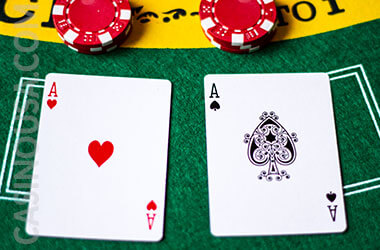- Slots
- Blackjack
- Roulette
- Live Dealer
- Baccarat
- Great selection of slots
- High-quality live dealer games
- Excellent welcome bonus
- Crypto-friendly
- Slots
- Blackjack
- Roulette
- Live Dealer
- Baccarat
- 300+ games
- Crypto-friendly casino
- Live dealer jackpot
- Bonus galore for different verticals
- Slots
- Blackjack
- Roulette
- Live Dealer
- Baccarat
- Accepts cryptocurrencies
- Generous welcome bonus
- Loyalty program
- Kahnawake Licence

However, this move is only good in certain scenarios, and in this article, we’ll give you a few tips on when exactly you should split pairs, regardless of whether they are aces or any other value.
What Does Splitting Mean in Blackjack?
Splitting in blackjack means playing your hole cards as two separate hands for the cost of doubling the initial bet.
In most variations of blackjack, only the cards with the same rank can be split, meaning a pair of 2s, 8s, aces, and others.
In some versions, you can even split different 10-value cards, like a jack and a queen. Furthermore, some blackjack variations allow you to re-split and continue making more hands after the initial split.
Value of Aces
An ace is the most special card in blackjack, as it can have two different values depending on the situation. Namely, an ace can have a value of 1 or 11. For instance, if you have a total of 16 and proceed to hit an ace, you won’t bust, and your hand will instead be considered to have a total of 17.
More importantly, the only way to get a natural blackjack is by getting an ace and one of the 10-value cards. But what if you get two aces? Is that any good? Should you split them?
When to Split Aces
 You should basically always split aces, and the reason is pretty obvious — there are multiple 10-value cards in the deck, so you will increase your chances of getting to 21.
You should basically always split aces, and the reason is pretty obvious — there are multiple 10-value cards in the deck, so you will increase your chances of getting to 21.
If you were to play your pair of aces without splitting, one of them would have a value of 11, and the other would be equal to 1, bringing you to a total of 12. This only leaves 9 as the card that will get you to the optimal 21.
If you draw a 10 after not splitting, both your aces will count as 1, and you’ll be back to a total of 12.
So, as mentioned, you should always split your aces, as it increases your chance of beating the dealer. However, don’t forget that this comes at a cost.
Namely, most casinos will only allow you to draw one additional card for each of the aces you’ve drawn, so you could still end up with a bad hand if you get a low-value card.
- Keep in mind that since you’re now playing the aces as two separate hands, you must double your original bet.
Another thing to note is that if you get a 10 over your split ace, it won’t count as a natural, so you won’t get an increased payout.
When to Split Pairs
Aces are commonly mentioned in the context of blackjack splitting, but they are not the only pair you should always split. Namely, splitting 8s also creates a beneficial scenario for the player.
When you draw two 8s, you are left with a total of 16. This means that hitting anything above 5 will bust you, but standing will leave you with a relatively weak hand. By splitting the 8s, you give yourself a much higher chance of beating the dealer with either hand.
Just like you should always split aces and 8s, there are certain pairs that should never be split. This is the case with 10s, 4s, and 5s — and here’s why.
Two 10s already give you a strong total of 20, which you are unlikely to improve if you split them.
With 4s, you get a total of 8, which means you can’t bust with your next hit — instead, you may potentially improve to a very strong 19. If you split the 4s, there are only three cards that could improve your original hand (5, 6, and 7).

In case you get a pair of 5s, you should avoid splitting them. In addition, you should double down if the dealer isn’t showing a 9, 10, or an ace. Two 5s equal 10, which is a great starting hand.
As you may have noticed, we haven’t mentioned a few other pairs — specifically, 2s, 3s, 6s, 7s, and 9s. This is because deciding whether splitting these pairs is good or not depends on the dealer’s up-card.
In general, you should only split 2s, 3s, and 7s if the dealer is showing anywhere between 2 and 7. Additionally, 9s should be split when the dealer is showing anything between 2 and 6, 8, or 9.
Finally, it’s advisable to split 6s when the dealer has anything between 2 and 6.
Conclusion
We hope that you liked this intro to splitting aces and pairs in blackjack. We say “intro” because there’s much more to discuss on this topic — specifically, all the different scenarios in which splitting can be beneficial, especially in relation to different blackjack variants.
Before starting to play any blackjack game, make sure to understand the rules related to splitting. Pay attention to 10-value cards and further splitting of hands in particular.
FAQ
- 21+3 Blackjack
- 6:5 Blackjack
- Advanced Strategy
- Atlantic City Blackjack
- Blackjack Bankroll Management
- Blackjack Etiquette
- Blackjack for Beginners
- Blackjack Odds and Probability
- Blackjack Soft Hands
- Blackjack Strategy Simulator
- Blackjack Switch
- Blackjack Terminology
- Blackjack Tournaments
- Blackjack vs. Pontoon
- Blackjack: Online vs. Offline
- Bonus
- Card Counting
- Card Counting Hi-Lo
- Dealer’s Up Card
- Double Attack
- Double Down
- Double Exposure Blackjack
- European
- Face-Up vs. Face Down
- Hard vs. Soft Hands in Blackjack
- Hit or Stand
- Hole Carding
- House Edge
- How to Win
- How to Win Live Blackjack
- Insurance
- Is Online Blackjack Legal in the US?
- Lucky Ladies Side Bet
- Mobile Blackjack
- Multi Deck
- Online Blackjack Rigged
- Online Blackjack vs. Live Blackjack
- Online Strategy
- Perfect Pairs
- Power Blackjack
- Progressive Betting
- Real Money Blackjack
- Rules
- Side Bets
- Single Deck
- Soft 17 in Blackjack
- Spanish 21
- Strategy
- Strategy Charts
- Surrender
- Variations
- Zappit



